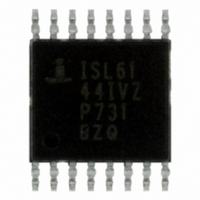ISL6144IVZA Intersil, ISL6144IVZA Datasheet - Page 22

ISL6144IVZA
Manufacturer Part Number
ISL6144IVZA
Description
IC CTRLR MOSFET ORING HV 16TSSOP
Manufacturer
Intersil
Datasheet
1.ISL6144IVZA.pdf
(29 pages)
Specifications of ISL6144IVZA
Applications
Telecom/Datacom Systems
Fet Type
N-Channel
Number Of Outputs
1
Internal Switch(s)
No
Delay Time - On
1ms
Delay Time - Off
250ns
Voltage - Supply
10 V ~ 75 V
Operating Temperature
-40°C ~ 105°C
Mounting Type
Surface Mount
Package / Case
16-TSSOP
Lead Free Status / RoHS Status
Lead free / RoHS Compliant
Current - Supply
-
Available stocks
Company
Part Number
Manufacturer
Quantity
Price
Company:
Part Number:
ISL6144IVZA
Manufacturer:
Intersil
Quantity:
304
Part Number:
ISL6144IVZA
Manufacturer:
INTERSIL
Quantity:
20 000
Company:
Part Number:
ISL6144IVZA-T
Manufacturer:
ST
Quantity:
3 200
This shows that worst-case failure scenario has to be
accounted for when choosing the ORing MOSFET. In both
cases, more than one ORing MOSFET/diode has to be
paralleled on each feed. Using parallel devices reduces
power dissipation per device and limits the junction
temperature rise to acceptable safe levels. Another
alternative is to choose a MOSFET with lower r
(Refer to Tables 1 and 2 for some examples).
If parallel MOSFETs are used on each feed, make sure to
use the same part number. Also it is preferable to have parts
from the same lot to insure load sharing between these
paralleled devices.
The final choice of the N-Channel ORing MOSFET depends
on the following aspects:
• Voltage Rating: The drain-source breakdown voltage
• Power Losses: In this application, the ORing MOSFET is
• The final MOSFET selection has to be based on the worse
• In the particular cases illustrated in the previous examples
• The MOSFET’s r
P
P
loss FET
loss FET
V
including transients and spikes. Also, the gate to source
voltage rating has to be considered. The ISL6144
maximum Gate charge voltage is 12V. Make sure the used
MOSFET has a maximum V
used as a series pass element, which is normally fully
enhanced at high load currents. Switching losses are
negligible. The major losses are conduction losses, which
depend on the value of the on-state resistance of the
MOSFET r
N + 1 redundant system with perfect current sharing, the
per feed MOSFET losses are:
case current when the system is reduced to N parallel
supplies due to a permanent failure of one unit. The
remaining units have to provide the full load current. In this
case, losses across each remaining ORing MOSFET
become Equation 15:
of Figures 29 and 30 with N = 1, each of the two ORing
feeds have to be able to handle the full load current.
temperature; a curve showing this relationship is usually
part of any MOSFET’s data sheet. The increase in the
value of the r
account.
DSS
(
(
has to be higher than the maximum input voltage,
)
)
=
=
DS(ON)
⎛
⎝
⎛
⎝
I
---------------- -
I
---------------- -
DS(ON)
LOAD
N
LOAD
N
+
1
DS(ON)
, and the per feed load current. For an
⎞
⎠
⎞
⎠
2
2
over-temperature has to be taken into
⋅
⋅
r
r
DS ON
DS ON
value also depends on junction
(
(
22
GS
)
)
rating >12V.
DS(ON)
(EQ. 15)
(EQ. 14)
ISL6144
• Current handling capability, steady state and peak, are
Suppose P
ambient thermal resistance R
copper pad area), T
maximum ambient board temperature = +85°C.
We need to make sure that the MOSFET’s junction
temperature during operation does not exceed the maximum
allowable device junction temperature.
In the example of Figure 30 with a load of 32A, at least 3
MOSFETs with r
dissipation to below 1W and operate with safe junction
temperature.
Tables 1 and 2 show MOSFET selection for some typical
applications with different input voltages and load currents in
a 1 + 1 redundant power system (a maximum of 1W of
power dissipation across each MOSFET is assumed).
For a 48V Input:
NOTES:
10. Number of parallel MOSFETs per feed
12. V
13. V
11. V
also two important parameters that must be considered.
The limitation on the maximum allowable drain current
comes from limitation on the maximum allowable device
junction temperature. The thermal board design has to be
able to dissipate the resulting heat without exceeding the
MOSFET’s allowable junction temperature.
T
T
T
J
J
J
I
Load_Max
= T
= +85°C+1W. +43°C/W = +128°C
< T
DSS
DSS
DSS
16A
32A
8A
A_max
JMAX
= 100V;I
= 100V; I
= 75V; I
Loss
TABLE 1. INPUT VOLTAGE = 48V
+ P
= 1W in a D2PAK MOSFET, junction to
DS(ON)
D
D
D
= 80A; r
FDB3632 (Note 11)
SUM110N10-08 (Note 12)
FDB3632 (Note 11)
SUM110N10-08
FDB045AN08A0 (Note 13)
FDB3632 (Note 11)
SUM110N10-08
FDB045AN08A0
= 80A; r
Loss
= 110A; r
JMAX
MOSFET PART NUMBER
• R
= 4.5mΩ are paralleled to limit the
DS(ON)
= +175°C, r
DS(ON)
θJA
DS(ON)
θJA
= 4.5m
= 9m
= +43°C/W (with 1 inch
= 9.5m
Ω
DS(ON)
Ω
Ω
= 4.5mΩ,
N (Note 10)
January 6, 2011
1
1
2
2
1
4
4
3
FN9131.6
2











